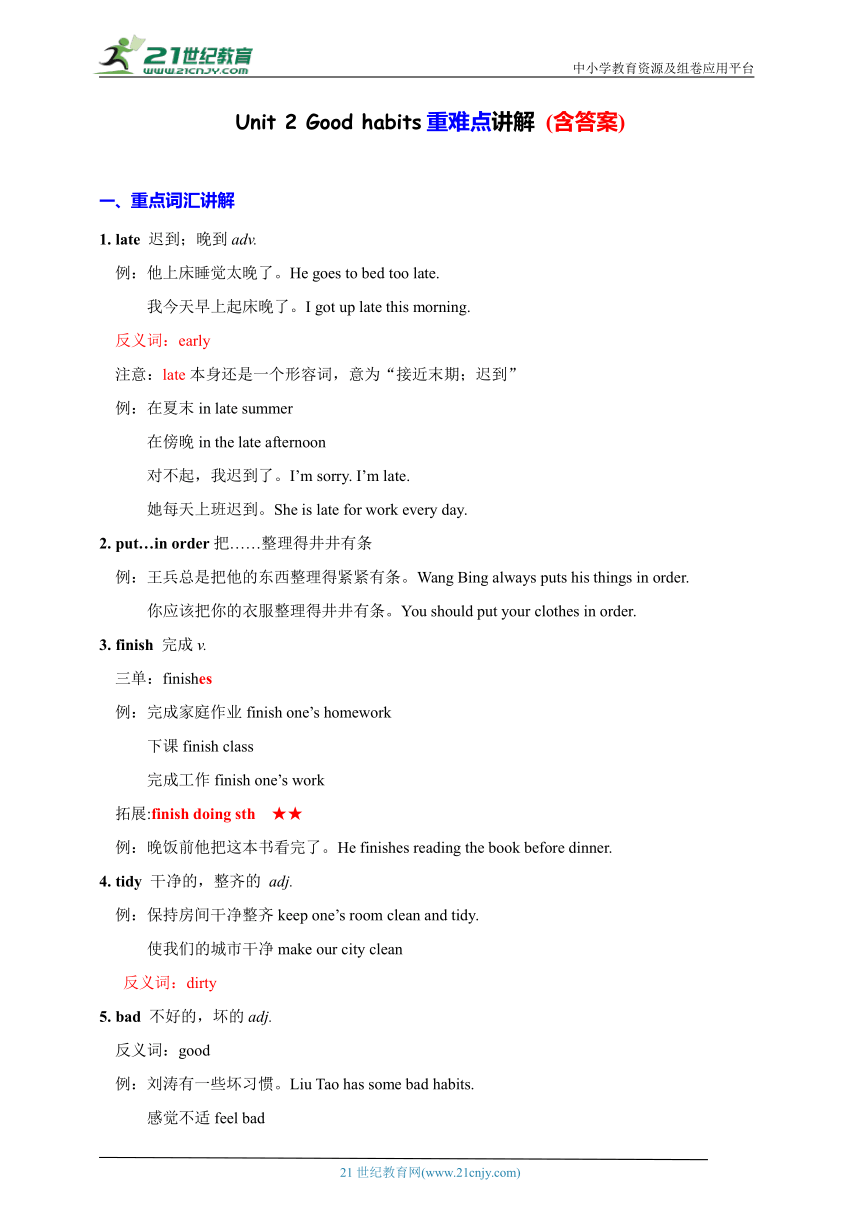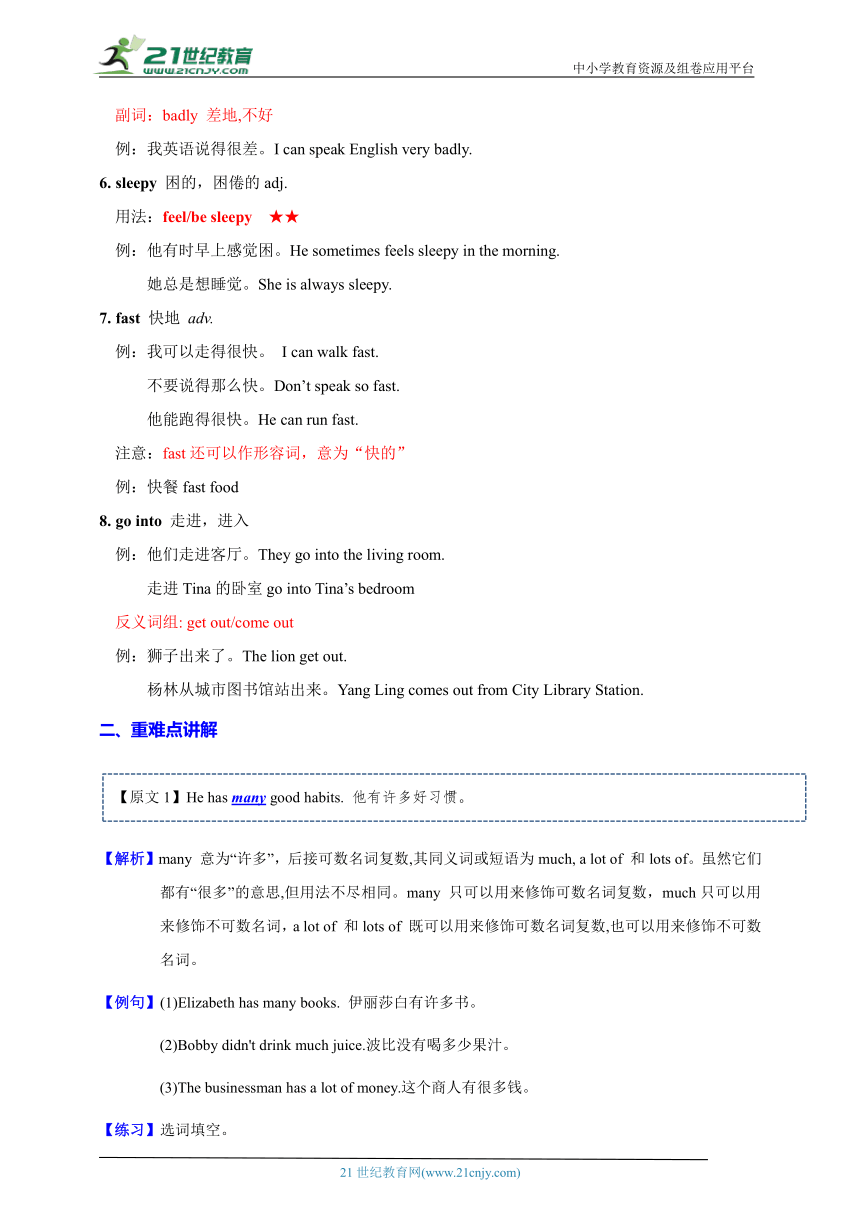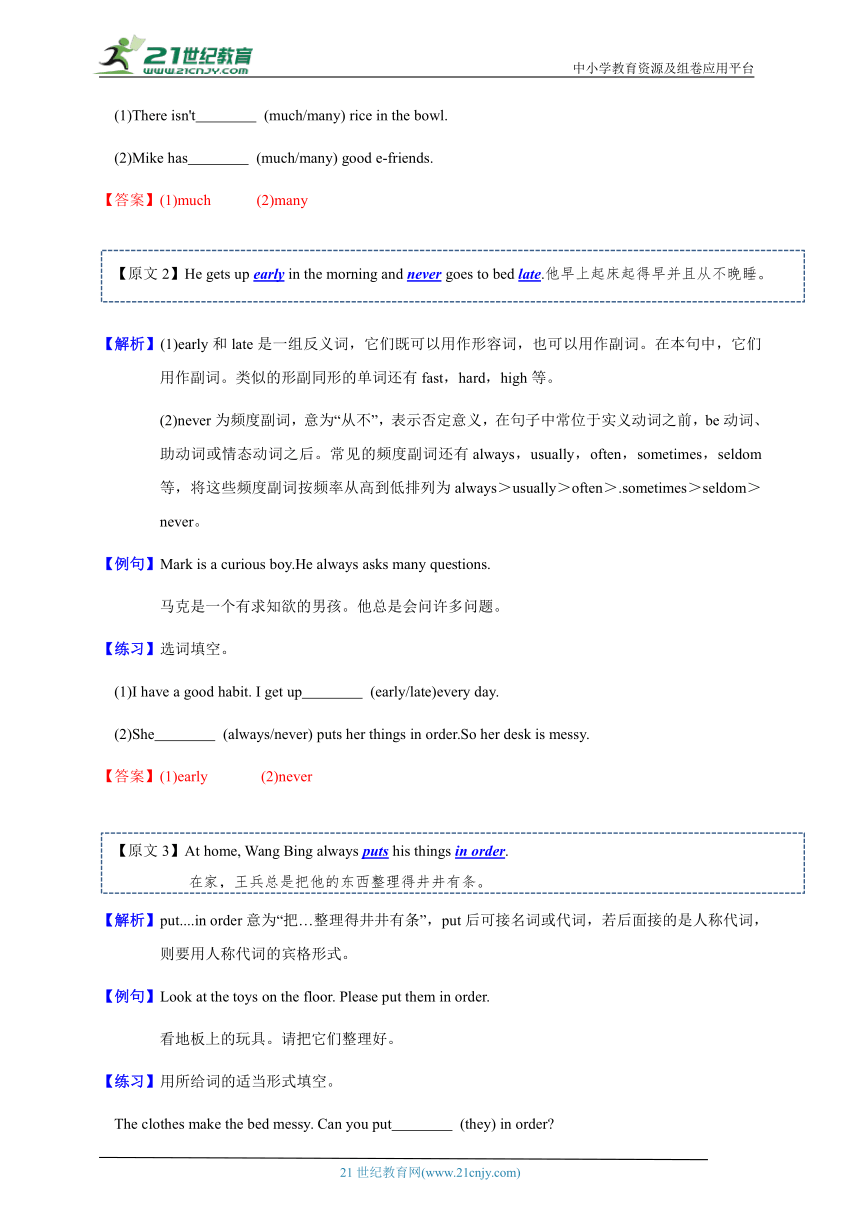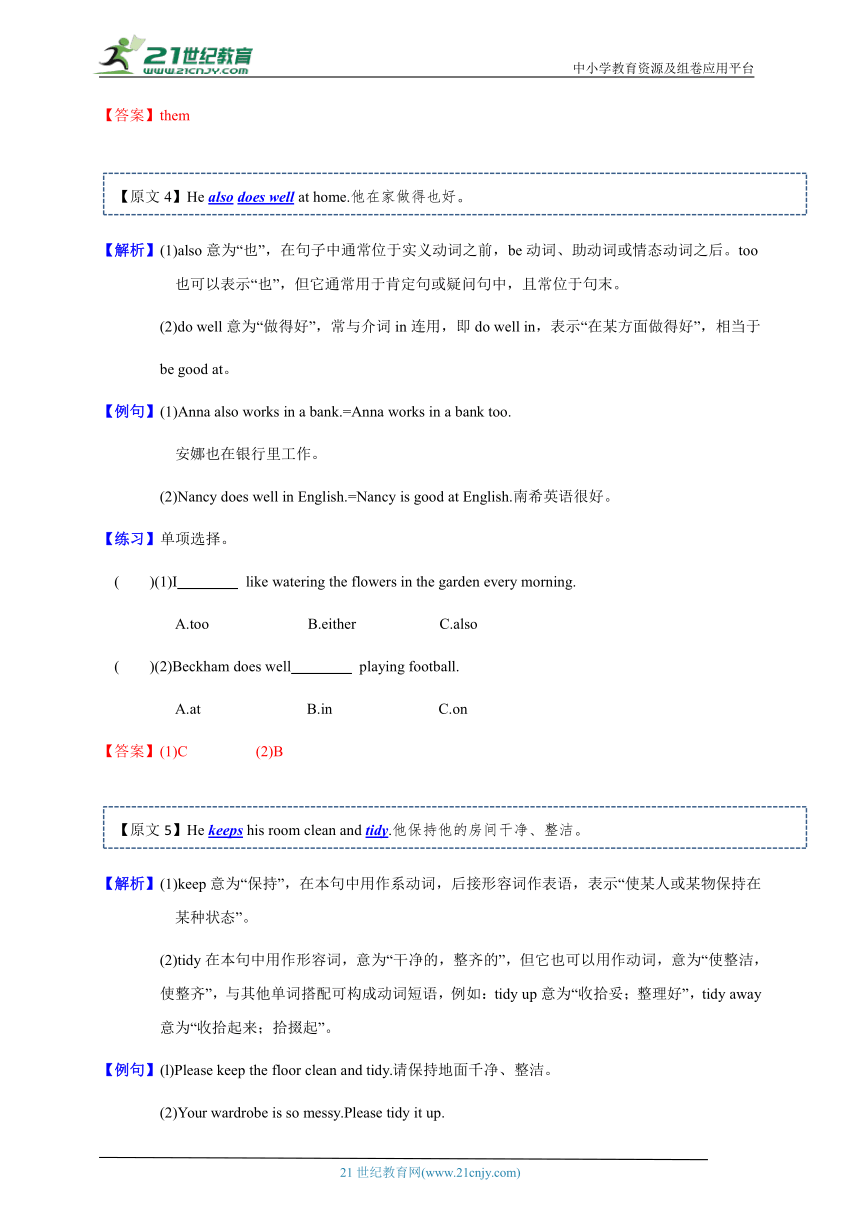Unit 2 Good habits重难点讲解 (含答案)
文档属性
| 名称 | Unit 2 Good habits重难点讲解 (含答案) |

|
|
| 格式 | docx | ||
| 文件大小 | 302.6KB | ||
| 资源类型 | 试卷 | ||
| 版本资源 | 牛津译林版 | ||
| 科目 | 英语 | ||
| 更新时间 | 2024-01-24 20:31:13 | ||
图片预览




文档简介
中小学教育资源及组卷应用平台
Unit 2 Good habits重难点讲解 (含答案)
重点词汇讲解
late 迟到;晚到adv.
例:他上床睡觉太晚了。He goes to bed too late.
我今天早上起床晚了。I got up late this morning.
反义词:early
注意:late本身还是一个形容词,意为“接近末期;迟到”
例:在夏末in late summer
在傍晚in the late afternoon
对不起,我迟到了。I’m sorry. I’m late.
她每天上班迟到。She is late for work every day.
put…in order把……整理得井井有条
例:王兵总是把他的东西整理得紧紧有条。Wang Bing always puts his things in order.
你应该把你的衣服整理得井井有条。You should put your clothes in order.
finish 完成v.
三单:finishes
例:完成家庭作业finish one’s homework
下课finish class
完成工作finish one’s work
拓展:finish doing sth ★★
例:晚饭前他把这本书看完了。He finishes reading the book before dinner.
tidy 干净的,整齐的 adj.
例:保持房间干净整齐keep one’s room clean and tidy.
使我们的城市干净make our city clean
反义词:dirty
bad 不好的,坏的adj.
反义词:good
例:刘涛有一些坏习惯。Liu Tao has some bad habits.
感觉不适feel bad
副词:badly 差地,不好
例:我英语说得很差。I can speak English very badly.
sleepy 困的,困倦的adj.
用法:feel/be sleepy ★★
例:他有时早上感觉困。He sometimes feels sleepy in the morning.
她总是想睡觉。She is always sleepy.
fast 快地 adv.
例:我可以走得很快。 I can walk fast.
不要说得那么快。Don’t speak so fast.
他能跑得很快。He can run fast.
注意:fast还可以作形容词,意为“快的”
例:快餐fast food
go into 走进,进入
例:他们走进客厅。They go into the living room.
走进Tina的卧室go into Tina’s bedroom
反义词组: get out/come out
例:狮子出来了。The lion get out.
杨林从城市图书馆站出来。Yang Ling comes out from City Library Station.
重难点讲解
【解析】many 意为“许多”,后接可数名词复数,其同义词或短语为much, a lot of 和lots of。虽然它们都有“很多”的意思,但用法不尽相同。many 只可以用来修饰可数名词复数,much只可以用来修饰不可数名词,a lot of 和lots of 既可以用来修饰可数名词复数,也可以用来修饰不可数名词。
【例句】(1)Elizabeth has many books. 伊丽莎白有许多书。
(2)Bobby didn't drink much juice.波比没有喝多少果汁。
(3)The businessman has a lot of money.这个商人有很多钱。
【练习】选词填空。
(1)There isn't (much/many) rice in the bowl.
(2)Mike has (much/many) good e-friends.
【答案】(1)much (2)many
【解析】(1)early和late是一组反义词,它们既可以用作形容词,也可以用作副词。在本句中,它们用作副词。类似的形副同形的单词还有fast,hard,high等。
(2)never为频度副词,意为“从不”,表示否定意义,在句子中常位于实义动词之前,be动词、助动词或情态动词之后。常见的频度副词还有always,usually,often,sometimes,seldom等,将这些频度副词按频率从高到低排列为always>usually>often>.sometimes>seldom>never。
【例句】Mark is a curious boy.He always asks many questions.
马克是一个有求知欲的男孩。他总是会问许多问题。
【练习】选词填空。
(1)I have a good habit. I get up (early/late)every day.
(2)She (always/never) puts her things in order.So her desk is messy.
【答案】(1)early (2)never
【解析】put....in order意为“把…整理得井井有条”,put后可接名词或代词,若后面接的是人称代词,则要用人称代词的宾格形式。
【例句】Look at the toys on the floor. Please put them in order.
看地板上的玩具。请把它们整理好。
【练习】用所给词的适当形式填空。
The clothes make the bed messy. Can you put (they) in order
【答案】them
【解析】(1)also意为“也”,在句子中通常位于实义动词之前,be动词、助动词或情态动词之后。too也可以表示“也”,但它通常用于肯定句或疑问句中,且常位于句末。
(2)do well意为“做得好”,常与介词in连用,即do well in,表示“在某方面做得好”,相当于
be good at。
【例句】(1)Anna also works in a bank.=Anna works in a bank too.
安娜也在银行里工作。
(2)Nancy does well in English.=Nancy is good at English.南希英语很好。
【练习】单项选择。
( )(1)I like watering the flowers in the garden every morning.
A.too B.either C.also
( )(2)Beckham does well playing football.
A.at B.in C.on
【答案】(1)C (2)B
【解析】(1)keep意为“保持”,在本句中用作系动词,后接形容词作表语,表示“使某人或某物保持在某种状态”。
(2)tidy在本句中用作形容词,意为“干净的,整齐的”,但它也可以用作动词,意为“使整洁,使整齐”,与其他单词搭配可构成动词短语,例如:tidy up意为“收拾妥;整理好”,tidy away意为“收拾起来;拾掇起”。
【例句】(l)Please keep the floor clean and tidy.请保持地面千净、整洁。
(2)Your wardrobe is so messy.Please tidy it up.
你的衣橱如此乱。请整理好它。
【练习】用所给词的适当形式填空。
The lady always (keep) her flat very (tidy).
Please keep your hands (clean), my boy.
【答案】(l)keeps,tidy (2)clean
【解析】show sb around.意为“带某人参观。”,show后面可以接名词或人称代词的宾格形式作宾语。另外,show sb around也可以单独使用,意为“带某人到处看看”。
【例句】(1)Can you show me around the library 你能带我参观一下这座图书馆吗?
(2)Do you want me to show you around 你想让我带你到处看看吗?
【练习】根据中文提示完成句子。
请带他参观一下你的新学校。
Please around your new school.
【答案】show him
【解析】go into意为“走进,走入”,into为介词,通常与表示位置移动的动词连用,表示“进入;到…里面”。
【例句】(l)I went into the yard quickly.。我快速地走进了院子。
(2)Mrs Johnson poured some tea into the cup.
约翰逊夫人把一些茶倒入了杯子里。
【练习】根据中文提示完成句子。
太危险了。请不要走进这幢大楼。
It's too dangerous. Please don't this building.
【答案】go into
易错易混全解
助动词的正确使用
【例题】按要求完成句子。
Yang Ling does well at school.(改为否定句)
Yang Ling well at school.
【答案】doesn't do
点拨:
将含有实义动词的一般现在时的肯定句改为否定句时,由于实义动词不能与否定词直接连用,因此要加上助动词do或does帮助构成否定句,如果原肯定句中的谓语动词为动词第三人称单数,还要将动词第三人称单数改为动词原形。本题肯定句中的does为实义动词do的第三人称单数形式,意为“做”,因为句子的主语Yang Ling为第三人称单数,所以将肯定句改为否定句时,表示否定要用“助动词does十否定词not”,再将原肯定句中的谓语动词does恢复成原形do。
形副同形单词的用法
【例题】用所给词的适当形式填空。
(1)Bobby, you were ten minutes (late) for class today.
(2)Don't come home (late), George.
【答案】(1)late (2)late
点拨:
late既可以用作形容词,也可以用作副词,用作形容词时译为“迟的,晚的”;用作副词时译为“迟,晚”。第(1)小题,be late for为固定搭配,此时late为形容词。第(2)小题,表示“回家回得晚”可以用come home late(此时late为副词,置于动词短语come home后对短语中的动词come进行修饰),但不可以用come home lately,lately虽然也是副词,但它的意思是“最近;近来”,用于此处与语境不符。
易混淆go into和go in的用法
【例题】选词填空。
(1)Let's (go into/go in). It's too cold outside
(2)Would you (go into/go in) the kitchen and heat up some soup
【答案】(1)going (2)go into
点拨:
go into和go in都有“进入”的意思,但在用法上却不同。go into为及物动词短语,后面要接表示地,点的名词(短语);而go in为不及物动词短语,可以单独使用,后面不需要接表示地,点的名词(短语)。第(1)小题,设空处位于第一句句末,且后面无表示地点的名词(短语),故填go in。第(2)小题,设空处后为表示地,点的名词短语the kitchen,故填go into。
21世纪教育网 www.21cnjy.com 精品试卷·第 2 页 (共 2 页)
21世纪教育网(www.21cnjy.com)
Unit 2 Good habits重难点讲解 (含答案)
重点词汇讲解
late 迟到;晚到adv.
例:他上床睡觉太晚了。He goes to bed too late.
我今天早上起床晚了。I got up late this morning.
反义词:early
注意:late本身还是一个形容词,意为“接近末期;迟到”
例:在夏末in late summer
在傍晚in the late afternoon
对不起,我迟到了。I’m sorry. I’m late.
她每天上班迟到。She is late for work every day.
put…in order把……整理得井井有条
例:王兵总是把他的东西整理得紧紧有条。Wang Bing always puts his things in order.
你应该把你的衣服整理得井井有条。You should put your clothes in order.
finish 完成v.
三单:finishes
例:完成家庭作业finish one’s homework
下课finish class
完成工作finish one’s work
拓展:finish doing sth ★★
例:晚饭前他把这本书看完了。He finishes reading the book before dinner.
tidy 干净的,整齐的 adj.
例:保持房间干净整齐keep one’s room clean and tidy.
使我们的城市干净make our city clean
反义词:dirty
bad 不好的,坏的adj.
反义词:good
例:刘涛有一些坏习惯。Liu Tao has some bad habits.
感觉不适feel bad
副词:badly 差地,不好
例:我英语说得很差。I can speak English very badly.
sleepy 困的,困倦的adj.
用法:feel/be sleepy ★★
例:他有时早上感觉困。He sometimes feels sleepy in the morning.
她总是想睡觉。She is always sleepy.
fast 快地 adv.
例:我可以走得很快。 I can walk fast.
不要说得那么快。Don’t speak so fast.
他能跑得很快。He can run fast.
注意:fast还可以作形容词,意为“快的”
例:快餐fast food
go into 走进,进入
例:他们走进客厅。They go into the living room.
走进Tina的卧室go into Tina’s bedroom
反义词组: get out/come out
例:狮子出来了。The lion get out.
杨林从城市图书馆站出来。Yang Ling comes out from City Library Station.
重难点讲解
【解析】many 意为“许多”,后接可数名词复数,其同义词或短语为much, a lot of 和lots of。虽然它们都有“很多”的意思,但用法不尽相同。many 只可以用来修饰可数名词复数,much只可以用来修饰不可数名词,a lot of 和lots of 既可以用来修饰可数名词复数,也可以用来修饰不可数名词。
【例句】(1)Elizabeth has many books. 伊丽莎白有许多书。
(2)Bobby didn't drink much juice.波比没有喝多少果汁。
(3)The businessman has a lot of money.这个商人有很多钱。
【练习】选词填空。
(1)There isn't (much/many) rice in the bowl.
(2)Mike has (much/many) good e-friends.
【答案】(1)much (2)many
【解析】(1)early和late是一组反义词,它们既可以用作形容词,也可以用作副词。在本句中,它们用作副词。类似的形副同形的单词还有fast,hard,high等。
(2)never为频度副词,意为“从不”,表示否定意义,在句子中常位于实义动词之前,be动词、助动词或情态动词之后。常见的频度副词还有always,usually,often,sometimes,seldom等,将这些频度副词按频率从高到低排列为always>usually>often>.sometimes>seldom>never。
【例句】Mark is a curious boy.He always asks many questions.
马克是一个有求知欲的男孩。他总是会问许多问题。
【练习】选词填空。
(1)I have a good habit. I get up (early/late)every day.
(2)She (always/never) puts her things in order.So her desk is messy.
【答案】(1)early (2)never
【解析】put....in order意为“把…整理得井井有条”,put后可接名词或代词,若后面接的是人称代词,则要用人称代词的宾格形式。
【例句】Look at the toys on the floor. Please put them in order.
看地板上的玩具。请把它们整理好。
【练习】用所给词的适当形式填空。
The clothes make the bed messy. Can you put (they) in order
【答案】them
【解析】(1)also意为“也”,在句子中通常位于实义动词之前,be动词、助动词或情态动词之后。too也可以表示“也”,但它通常用于肯定句或疑问句中,且常位于句末。
(2)do well意为“做得好”,常与介词in连用,即do well in,表示“在某方面做得好”,相当于
be good at。
【例句】(1)Anna also works in a bank.=Anna works in a bank too.
安娜也在银行里工作。
(2)Nancy does well in English.=Nancy is good at English.南希英语很好。
【练习】单项选择。
( )(1)I like watering the flowers in the garden every morning.
A.too B.either C.also
( )(2)Beckham does well playing football.
A.at B.in C.on
【答案】(1)C (2)B
【解析】(1)keep意为“保持”,在本句中用作系动词,后接形容词作表语,表示“使某人或某物保持在某种状态”。
(2)tidy在本句中用作形容词,意为“干净的,整齐的”,但它也可以用作动词,意为“使整洁,使整齐”,与其他单词搭配可构成动词短语,例如:tidy up意为“收拾妥;整理好”,tidy away意为“收拾起来;拾掇起”。
【例句】(l)Please keep the floor clean and tidy.请保持地面千净、整洁。
(2)Your wardrobe is so messy.Please tidy it up.
你的衣橱如此乱。请整理好它。
【练习】用所给词的适当形式填空。
The lady always (keep) her flat very (tidy).
Please keep your hands (clean), my boy.
【答案】(l)keeps,tidy (2)clean
【解析】show sb around.意为“带某人参观。”,show后面可以接名词或人称代词的宾格形式作宾语。另外,show sb around也可以单独使用,意为“带某人到处看看”。
【例句】(1)Can you show me around the library 你能带我参观一下这座图书馆吗?
(2)Do you want me to show you around 你想让我带你到处看看吗?
【练习】根据中文提示完成句子。
请带他参观一下你的新学校。
Please around your new school.
【答案】show him
【解析】go into意为“走进,走入”,into为介词,通常与表示位置移动的动词连用,表示“进入;到…里面”。
【例句】(l)I went into the yard quickly.。我快速地走进了院子。
(2)Mrs Johnson poured some tea into the cup.
约翰逊夫人把一些茶倒入了杯子里。
【练习】根据中文提示完成句子。
太危险了。请不要走进这幢大楼。
It's too dangerous. Please don't this building.
【答案】go into
易错易混全解
助动词的正确使用
【例题】按要求完成句子。
Yang Ling does well at school.(改为否定句)
Yang Ling well at school.
【答案】doesn't do
点拨:
将含有实义动词的一般现在时的肯定句改为否定句时,由于实义动词不能与否定词直接连用,因此要加上助动词do或does帮助构成否定句,如果原肯定句中的谓语动词为动词第三人称单数,还要将动词第三人称单数改为动词原形。本题肯定句中的does为实义动词do的第三人称单数形式,意为“做”,因为句子的主语Yang Ling为第三人称单数,所以将肯定句改为否定句时,表示否定要用“助动词does十否定词not”,再将原肯定句中的谓语动词does恢复成原形do。
形副同形单词的用法
【例题】用所给词的适当形式填空。
(1)Bobby, you were ten minutes (late) for class today.
(2)Don't come home (late), George.
【答案】(1)late (2)late
点拨:
late既可以用作形容词,也可以用作副词,用作形容词时译为“迟的,晚的”;用作副词时译为“迟,晚”。第(1)小题,be late for为固定搭配,此时late为形容词。第(2)小题,表示“回家回得晚”可以用come home late(此时late为副词,置于动词短语come home后对短语中的动词come进行修饰),但不可以用come home lately,lately虽然也是副词,但它的意思是“最近;近来”,用于此处与语境不符。
易混淆go into和go in的用法
【例题】选词填空。
(1)Let's (go into/go in). It's too cold outside
(2)Would you (go into/go in) the kitchen and heat up some soup
【答案】(1)going (2)go into
点拨:
go into和go in都有“进入”的意思,但在用法上却不同。go into为及物动词短语,后面要接表示地,点的名词(短语);而go in为不及物动词短语,可以单独使用,后面不需要接表示地,点的名词(短语)。第(1)小题,设空处位于第一句句末,且后面无表示地点的名词(短语),故填go in。第(2)小题,设空处后为表示地,点的名词短语the kitchen,故填go into。
21世纪教育网 www.21cnjy.com 精品试卷·第 2 页 (共 2 页)
21世纪教育网(www.21cnjy.com)
